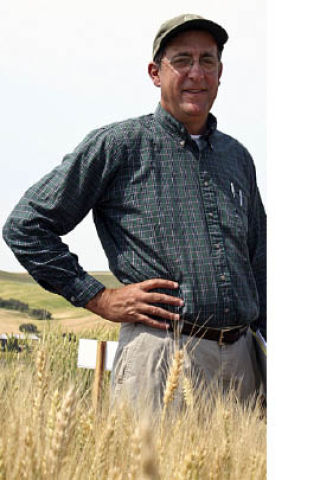One challenge to an all-island diet is finding locally grown grains. With this challenge in mind, 30 islanders, many with experience growing and harvesting grains here, met in Friday Harbor in late September for a WSU Extension workshop titled “Growing Grains.”
Dr. Stephen S. Jones, nationally and internationally recognized wheat breeder from WSU at Pullman and, beginning in May 2009, director of WSU’s Northwestern Washington Research and Extension Center at Mount Vernon, described what he and WSU researcher Carol Miles are doing to help low chemical input and certified organic farmers as well as conventional farmers in western Washington grow, harvest and use wheat and other grains.
The task is “taking what we know there and helping you folks here” Steve said as he began his presentation. “We’re very interested in the local input.”
A first step is finding varieties that do well here in western Washington. “Our goal is to have yield trials or at least observations in all seven northwest counties,” he explained, adding that this fall at the center in Mt. Vernon, “we’re planting 90 varieties of hard and soft wheat,” both heirloom wheats and crosses of heirloom and modern wheats, as well as standard modern varieties commonly available.
After encouraging anyone interested in participating in the trials or observations to contact Candace Jagel for details, Steve shifted gears: “Getting wheat to emerge and grow is pretty simple. If you have the right variety it won’t fall over; it will mature at a certain time. Then what?”
“The difficulty is at harvest,” he said, smiling as he showed a picture of a Japanese rice sickle, the tool that he and his researchers use to cut enough wheat to tie into a bundle with a pre-cut length of string before moving on to cut and tie the next bundle.
In another picture, he showed his crew threshing the bundles in a Vogel thresher, developed at WSU. “We lower the bundle in and then pull it out and toss the bundle aside, using it later for mulch. The seed is knocked out of the head and drops down to a tray; a fan blows a tremendous volume of air and the winnowed seed drops to a larger tray at the bottom.”
“We have one or two of these at the Mt. Vernon Center,” he said, but “someone very handy could make one or the county could acquire one.”
Though he was focusing on strategies for harvesting with a sickle and thresher, he agreed that “the best thing to have is an old combine,” but he added, “you better be mechanical and you better buy a couple.” As small-scale grain growing returns to places like the San Juan Islands, he said, “There’s an industry for someone who is very mechanical to buy up old combines and go farm to farm.”
Turning to the grain itself, Steve said they’re interested in “hooking up with local bakers, working side by side to develop varieties that do well for them.” The bottleneck here, though, is a lack of mills. “There’s a whole infrastructure that has been lost,” he said sadly, “but you only need one mill for the island and there are still sources for some very nice little stone mills.”
Taking the long view as he concluded his presentation, Steve said, “When you’re talking about sustainable agriculture, by definition you’re talking about time. Be patient with us but help us out too. We’ll be working county by county to get varieties. That’s the first step and then we’ll just go from there.”
For information on participating in wheat and other grain trials and observations and for sources for the Japanese rice sickle, contact Candace Jagel, WSU Ag Coordinator, at 360-370-7664 or candace_jagel@wsu.edu. To join a local wiki on grains, contact Neal Foley at podchef@gmail.com.



